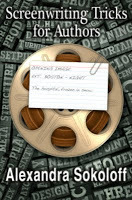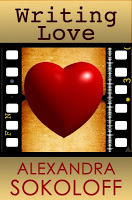I got a great
question in the comments a couple of weeks ago and wanted to expand on it in a post.
I don't completely understand what a sequence is. I can tell you its climax will have a setpiece, will deliver on the premise, will be a genre scene, has a beginning, middle, and end, there are eight of them in a movie . . . But I don't understand EXACTLY what is a sequence. I understand an Act, I understand a scene. Can you help me understand the difference between sequence and scene (besides that a sequence is series of scenes)?
Well, I think I know exactly what is confusing you about sequences, and the reason is because it's confusing.
The confusion is because we're talking about two different kinds of sequences.
1. When I talk about the "Eight Sequence Structure", that's a term very specific to movies (that I think is useful to understand and work with when writing novels). See
full explanation here:
BUT --
2. The term "sequence"actually is more often used to mean something different, which is - "a collection of scenes focused on a single central action (and sometimes taking place in the same location, in real time) with a beginning, middle and end."
Really, when I'm talking about the eight sequences of a movie, a better term would be SEGMENT. Because Sequence One, or Segment One, of a movie might be just one SEQUENCE, as I defined in #2 above, but more often it will be composed of two or three SEQUENCES as defined in #2.
For example, Sequence One (or Segment One) of Raiders of the Lost Ark, which you could call the South America sequence, or the Cave sequence, is also a complete SEQUENCE unto itself. It is composed of several scenes all focused on one central action (stealing the gold idol), taking place in approximately the same location and in a discrete time frame. (That is, there is unity of time, space and action, which I really should do a whole other post about, but if you're not familiar with this concept, check out what
Aristotle had to say about it.) There's the approach to the cave, finding the cave, the perils inside the cave, the snatching of the idol, the escape from the cave, the reversal that rival Belloq and the warriors take the idol away from Indy, and the escape from the warriors and departure in the plane. It's all continuous action with one particular goal (that turns to simple survival in the end.) (My
breakdown is here ).
But more often what is called Sequence One of a movie (or book), that is, the first segment, will not be as unified and cohesive as that; instead of being one unified sequence as in the example from Raiders above, it will ramble through different scenes you could loosely call the SET UP, which will usually end with a twist or revelation that will take the action in another direction.
In fact, I would start calling the eight sequences eight SEGMENTS here for clarity, but it's never a good idea to mess around with such an entrenched vocabulary. I'm just going to have to be more clear about it in subsequent posts.
There are very few movies or books in which each of the eight Sequences (or Segments) are actually discrete sequences, too, but some come close (usually classic movies, which tended to have more defined sequences partly because they were shot almost entirely on sets. A set goes a long way toward imposing unity of action.).
For example, Four Weddings and a Funeral has very clear sequences, with each Act actually marked off by the wedding invitation cards announcing the bride and groom of each wedding (as you look more critically at films, you'll see that filmmakers LOVE to find that kind of visual act curtain; you see it at work in all kinds of movies: The Sting, Chinatown, Raiders of the Lost Ark, The Professional, Collateral – and that's just off the top of my head.) In Four Weddings each quarter of the movie (Act 1, Act 2:1, Act 2:2, Act 3) takes place at a different wedding, and each wedding is divided into the same basic parts: The wedding itself, the reception, then the love plot between Hugh Grant and Andie MacDowell as they leave the reception to go tryst. This is a great structural pattern to follow because it's so like real life. The wedding is a completely different experience than the reception/party that follows the wedding, and the party after the party is even better, a lot of the time. Although sometimes not.
You'll see that three-part pattern happens twice, in Act One and Act II:1, then Act II:2 is divided into a wedding and a reception, then a funeral and its aftermath, and then Act III is divided into pre-wedding, the interrupted wedding, and the aftermath (and the wonderful wrap-up in the closing credits).
It's great if you can find that clear of a structure in your own story, but YOU DON'T HAVE TO BE THAT PRECISE! Please don't kill yourself trying to find a perfect mathematical structure for your story; we writers have enough OCD issues already. However, as you get more attuned to how other storytellers use sequences, you will find that especially when you do rewrites, you will be able to craft scenes into more coherent sequences that give more of a flow and urgency to your story. And the idea of the eight-sequence structure can help you find the logical breaking points for sequences.
If you're struggling with the idea of sequences, in either sense of the word, my suggestion as always is to take several of your favorite movies and watch them specifically looking for how the filmmakers are using sequences. You'll soon catch on to how sequences keep the action flowing and the interest high, and that will keep you on the lookout for ways to combine more of your scenes into sequences.
I hope that's a little more clear, but if it's not, I'm happy to answer questions about it and discuss more examples.
-
Alex-----------------------------------------------------------------------------------
If you're looking for examples of the Three-Act, Eight-Sequence Structure in action, I strongly recommend that you watch at least one and much better, three of the films I break down in the workbooks, following along with my notes.
I do full breakdowns of Chinatown, Harry Potter and the Sorcerer's Stone, Romancing the Stone, and The Mist, and act breakdowns of You've Got Mail, Jaws, Silence of the Lambs, Raiders of the Lost Ark in Screenwriting Tricks For Authors.
I do full breakdowns of The Proposal, Groundhog Day, Sense and Sensibility, Romancing the Stone, Leap Year, Notting Hill, Four Weddings and a Funeral, Sea of Love, While You Were Sleeping and New in Town in Writing Love.
=====================================================
Screenwriting Tricks for Authors and Writing Love, Screenwriting Tricks for Authors, II, are now available in all e formats and as pdf files. Either book, any format, just $2.99.
 - Smashwords
- Smashwords (includes pdf and online viewing)
-
Kindle-
Barnes & Noble/Nook-
Amazon UK-
Amaxon DE (Eur. 2.40)

-
Smashwords (includes online viewing and pdf file)
-
Amazon/Kindle-
Barnes & Noble/Nook-
Amazon UK-
Amazon DE-------------------------------------------------------------------

 newest »
newest »
 newest »
newest »
 This was very helpful. I, too, was having a problem with understanding a sequence. A sequence is several units where the protagonist is after one goal. Upon either reaching the goal or being thwarted, the goal changes and moves in another direction. Is that right?
This was very helpful. I, too, was having a problem with understanding a sequence. A sequence is several units where the protagonist is after one goal. Upon either reaching the goal or being thwarted, the goal changes and moves in another direction. Is that right?
 Okay, this is what makes defining "sequence" so slippery. Yes, Alice, you're right, that is A definition of a KIND of sequence, but it's not the only kind of sequence there is. The South America/Cave sequence from Raiders I described above is a good example of that kind of sequence.
Okay, this is what makes defining "sequence" so slippery. Yes, Alice, you're right, that is A definition of a KIND of sequence, but it's not the only kind of sequence there is. The South America/Cave sequence from Raiders I described above is a good example of that kind of sequence. Here's another thing to keep in mind: it's very often not until your second draft (or third, or fourth) that you begin to see patterns in your story that you can pull together - do a little cutting, a little polishing - to create sequences. This is a true joy of writing, and you WILL get better at it.
Here's another thing to keep in mind: it's very often not until your second draft (or third, or fourth) that you begin to see patterns in your story that you can pull together - do a little cutting, a little polishing - to create sequences. This is a true joy of writing, and you WILL get better at it.
 Thank you. I keep reminding myself of the words in your screenwriting tips for writers. Your first draft is always going to suck. So I tell myself, keep going, it sucks, but it will get better. It sucks, keep going, it sucks, keep going. Ha. Kind of like the little engine that could.
Thank you. I keep reminding myself of the words in your screenwriting tips for writers. Your first draft is always going to suck. So I tell myself, keep going, it sucks, but it will get better. It sucks, keep going, it sucks, keep going. Ha. Kind of like the little engine that could.





